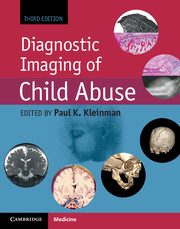Book contents
- Frontmatter
- Dedication
- Contents
- List of Contributors
- Editor’s note on the Foreword to the third edition
- Foreword to the third edition
- Foreword to the second edition
- Foreword to the first edition
- Preface
- Acknowledgments
- List of acronyms
- Introduction
- Section I Skeletal trauma
- Chapter 1 The skeleton: structure, growth and development, and basis of skeletal injury
- Chapter 2 Skeletal trauma: general considerations
- Chapter 3 Lower extremity trauma
- Chapter 4 Upper extremity trauma
- Chapter 5 Bony thoracic trauma
- Chapter 6 Dating fractures
- Chapter 7 Differential diagnosis I: diseases, dysplasias, and syndromes
- Chapter 8 Differential diagnosis II: disorders of calcium and phosphorus metabolism
- Chapter 9 Differential diagnosis III: osteogenesis imperfecta
- Chapter 10 Differential diagnosis IV: accidental trauma
- Chapter 11 Differential diagnosis V: obstetric trauma
- Chapter 12 Differential diagnosis VI: normal variants
- Chapter 13 Evidence-based radiology and child abuse
- Chapter 14 Skeletal imaging strategies
- Chapter 15 Postmortem skeletal imaging
- Section II Abusive head and spinal trauma
- Section III Visceral trauma and miscellaneous abuse and neglect
- Section IV Diagnostic imaging of abuse in societal context
- Section V Technical considerations and dosimetry
- Index
- References
Chapter 14 - Skeletal imaging strategies
from Section I - Skeletal trauma
Published online by Cambridge University Press: 05 September 2015
- Frontmatter
- Dedication
- Contents
- List of Contributors
- Editor’s note on the Foreword to the third edition
- Foreword to the third edition
- Foreword to the second edition
- Foreword to the first edition
- Preface
- Acknowledgments
- List of acronyms
- Introduction
- Section I Skeletal trauma
- Chapter 1 The skeleton: structure, growth and development, and basis of skeletal injury
- Chapter 2 Skeletal trauma: general considerations
- Chapter 3 Lower extremity trauma
- Chapter 4 Upper extremity trauma
- Chapter 5 Bony thoracic trauma
- Chapter 6 Dating fractures
- Chapter 7 Differential diagnosis I: diseases, dysplasias, and syndromes
- Chapter 8 Differential diagnosis II: disorders of calcium and phosphorus metabolism
- Chapter 9 Differential diagnosis III: osteogenesis imperfecta
- Chapter 10 Differential diagnosis IV: accidental trauma
- Chapter 11 Differential diagnosis V: obstetric trauma
- Chapter 12 Differential diagnosis VI: normal variants
- Chapter 13 Evidence-based radiology and child abuse
- Chapter 14 Skeletal imaging strategies
- Chapter 15 Postmortem skeletal imaging
- Section II Abusive head and spinal trauma
- Section III Visceral trauma and miscellaneous abuse and neglect
- Section IV Diagnostic imaging of abuse in societal context
- Section V Technical considerations and dosimetry
- Index
- References
Summary
Overview
In some respects, the principles governing the imaging approach to suspected abuse are no different from those used in the evaluation of accidental injuries and nontraumatic processes. The initial strategy is to identify and characterize the pathologic process responsible for the clinical findings. When abuse has occurred, the diagnosis may be evident on the basis of these initial imaging studies and the clinical data. Further studies are usually necessary to document the full extent of injury, including identification and characterization of all skeletal abnormalities as well as careful assessment for other differential considerations. In particular, the imaging features should be assessed for their specificity for abuse, as well as their age. The purpose of this approach is to provide the investigative agencies with a thorough documentation of the number and nature of all traumatic injuries. The inexperienced physician, as well as the seasoned clinician with little awareness of the complexities of some cases, may operate under the presumption that a medical diagnosis of abuse equals a medico-legal diagnosis (see Chapters 25–27). Those practitioners familiar with the vagaries of the judicial process usually understand that imaging data that securely support a diagnosis of abuse on medical grounds may fall short of that legally required in care and protection and criminal proceedings. Additionally, there are wide variations in the sophistication of the courts regarding the current concepts of physical child abuse, and in particular the significance of various imaging features. What may suffice to support the burden of proof in one courtroom may be inadequate in another.
When child abuse is present, the appropriate authorities should be sufficiently informed of the imaging findings and their implications to make judgments regarding the protection of the child and others at risk (Fig. 14.1). When the evaluation fails to confirm abuse or reveals some other cause for the clinical concerns, the child’s medical issues can be managed with the least disruption to the family unit.
- Type
- Chapter
- Information
- Diagnostic Imaging of Child Abuse , pp. 324 - 334Publisher: Cambridge University PressPrint publication year: 2015
References
- 2
- Cited by



